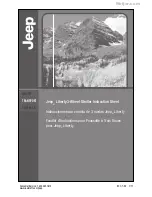
Project 06/2005
Danaher
Motion
66 Rev
E
M-SS-005-03l
3.6.10. Jerk
Units
It is also necessary to define the jerk factor, even if you always use the
smooth factor. The smooth factor automatically defines the jerk value from
the velocity and acceleration values, but it is a value before factors, therefore
totally invalid values of jerk (internally) can be computed. At least set
Jfac=Afac/1000 and it should work.
<axis>.JERKFACTOR
specifies the
conversion factor between your jerk units and the internal units [counts per
msec
3
].
<axis>.JERKFACTOR
must contain the conversion factor for both
the position dimension and the time dimension.
3. 7
A
CCELERATION
P
ROFILE
The MC provides smooth, controlled acceleration profiles to reduce vibration
and wear on the machine, and to allow high acceleration rates. The
SERVO
STAR
MC allows you to independently control acceleration and
deceleration to further reduce vibration. For detailed information any listed
commands, refer to the
SERVOSTAR
®
MC Reference Manual
.
ACCELERATION
and
DECELERATION
control the acceleration rates. The
following lines of code entered at the terminal window (or in your program)
change the acceleration rates for Axis A1:
A1.Acceleration = 1000
A1.Deceleration = 1000
Do not enter these commands yet. Acceleration units should be set before
these values are entered. You can impose limits which constrain the time
during which acceleration and deceleration occurs. The motion includes
three major parts: acceleration phase, constant velocity cruise phase, and
deceleration phase.
Time-based Acceleration/Deceleration is the motion interface in which the
duration of the acceleration/deceleration phases during the movement is
defined. These duration times will be used internally to calculate proper
motion parameters to meet the time requirements as accurate as possible.
<axis/group>.TIMEACCELERATION
and
<axis/group>.TIMEDECELERATION
can be used for time-based definition.
Jerk is the first derivative of acceleration. Fast moves usually generate large
amounts of jerk. Having a large amount of jerk in a motion profile can excite
machine resonance frequencies and thereby, cause unnecessary wear and
noise. Some motion controllers simplify motion profiles by instantaneously
changing the acceleration command which implies a very high level of jerk.
The MC allows you to limit the amount of jerk in all profiles by using the axis
properties
SMOOTHFACTOR
or
JERKFACTOR
.
Specify trapezoidal profiles by setting
SMOOTHFACTOR
(
SMOOTH
) to
zero. If you want a smoother acceleration, increase the
SMOOTHFACTOR
from 1to a maximum of 100. If
SMOOTHFACTOR
is large (greater than 50),
it can increase the acceleration time by one or more orders of magnitude.
Using
<axis>.ACCELERATION
and
<axis>.JERK
to limit velocity changes
produces acceleration profiles that remove the high frequency components
of torque that are present in straight-line acceleration. This minimizes the
excitation of machine resonance frequencies which in turn reduces audible
noise, vibration, and mechanical wear. For example, the figure below shows
a typical MC acceleration profile showing how controlled jerk produces
smooth acceleration.
















































